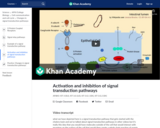
Using the signal transduction pathway for the cholera toxin to understand activation and inhibition.
- Subject:
- Biology
- Life Science
- Material Type:
- Lesson
- Provider:
- Khan Academy
- Provider Set:
- Khan Academy
- Author:
- Sal Khan
- Date Added:
- 10/31/2018

Using the signal transduction pathway for the cholera toxin to understand activation and inhibition.

Active listening is really the application of the Golden Rule and perhaps the most critical skill for resolving conflict. To know how to listen to someone else, think about how you would want to be listened to. While the ideas are largely intuitive, it might take some practice to develop (or re-develop) the skills.
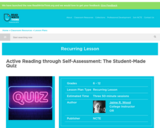
This recurring lesson encourages students to comprehend their reading through inquiry and collaboration. They choose important quotations from the text and work in groups to formulate "quiz" questions that their peers will answer.
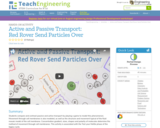
Students compare and contrast passive and active transport by playing a game to model this phenomenon. Movement through cell membranes is also modeled, as well as the structure and movement typical of the fluid mosaic model of the cell membrane. Concentration gradient, sizes, shapes and polarity of molecules determine the method of movement through cell membranes. This activity is associated with the Test your Mettle phase of the legacy cycle.

El Panel Nacional de Lectura (2000) identificó cinco áreas críticas clave para una enseñanza eficaz de la lectura. Esta guía le ayudará a asistir a su hijo a mejorar en cada una de las habilidades de alfabetización para que pueda convertirse en un gran lector y escritor. Usted desempeña un rol importante en este proceso. Esta guía le brinda algunas ideas sobre actividades que puede realizar con su hijo en casa para ayudarle a convertirse en un mejor lector. Las ideas incluyen descripciones detalladas de actividades basadas en evidencia y apoyos, así como una plantilla para practicar en casa. Además, para obtener más información sobre las áreas críticas de la enseñanza de la lectura, utilice los códigos QR.
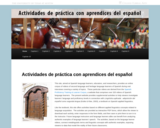
Actividades de práctica con aprendices del español is an online corpus of videos of second language and heritage language learners of Spanish during oral interviews and provides supplemental activities to help viewers investigate learners’ language and proficiency levels.

The United States has a long history of activists seeking social, political, economic, and other changes to Americaalong with a history of other activists trying to prevent such changes. American activism covered a wide range of causes and utilized many different forms of activism. American sociopolitical activism became especially prominent during the period of societal upheaval which began during the 1950s. The African American civil rights movement led the way, soon followed by a substantial anti-war movement opposing American involvement in the Vietnam War, and later by vigorous activism involving womens issues, gay rights, and other causes. The United States remains a land of nearly constant change, and activists play a significant role in the ongoing evolution of American democracy. It seems likely that Americans will remain enthusiastic activists in the future. This exhibition is part of the Digital Library of Georgia.

In this lesson, students will learn about how Harriet Beecher Stowe fought against the injustice of slavery. They will also consider ways in which they can fight injustices in their own lives.

This is an activity for exploring the resource document: Important Dates in the Voting History of the United States. The activity can be used at any grade level. The difficulty will be based on the expectations for the student groups.

Use this lesson as the foundation for the Stamp Act Resistance Narrative, The Boston Massacre Narrative, and The Boston Tea Party Narrative.
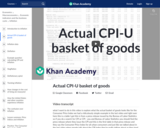
Exploring the actual weightings for the CPI-U basket of goods. Created by Sal Khan.
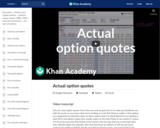
In this video we use some examples of actual option quotes to better understand options as a financial derivative. Created by Sal Khan.

Adaptaciones realizadas habitualmente para apoyar a los estudiantes con características de dislexia
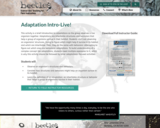
This activity is a brief introduction to adaptations as the group observes a live organism together. Adaptations are inheritable structures and behaviors that help a group of organisms survive in their habitat. Students start out observing an organisms’ structures, trying to figure which might help it survive in its habitat and which are inheritable. Then, they do the same with behaviors: attempting to figure out which ones are behavioral adaptations. To build understanding of a complex concept like adaptations, students need multiple exposures to it, which is why this activity should be followed by other adaptations-focused activities.
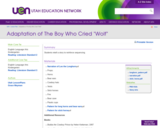
This activity focuses on retelling and performing a story that has been formatted from a traditional version to the setting of the Old West. When retelling a story to someone else, it is important to have the sequence and all parts to the story in correct order. The beginning of a story generally tells who the characters in the story are and what the problems may be. The middle generally explains what attempts were made to solve the problems, and the end generally has the solution, results, and how the story ends. For this activity, students should be familiar with the original tale so they will see the parallel between the original and the adapted version. As you are preparing to retell/role-play the story, you will need to discuss the main characters the students will be portraying and decide what simple props, if any, may be helpful in telling the story.
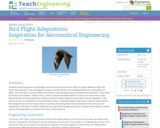
This activity first asks the students to study the patterns of bird flight and understand that four main forces affect the flight abilities of a bird. They will study the shape, feather structure, and resulting differences in the pattern of flight. They will then look at several articles that feature newly designed planes and the birds that they are modeled after. The final component of this activity is to watch the Nature documentary, "Raptor Force" which chronicles the flight patterns of birds, how researchers study these animals, and what interests our military and aeronautical engineers about these natural adaptations. This activity serves as an extension to the biomimetics lesson. Although students will not be using this information in the design process for their desert resort, it provides interesting information pertaining to the current use of biomimetics in the field of aviation. Students may extend their design process by using this information to create a means of transportation to and from the resort if they chose to.

Finches on the Galapagos Islands have evolved to exploit almost every possible niche. This diagram shows the range of food sources available on the island and the different beak shapes adapted to exploit each of them.

The true tale of the Recycled Orchestra of Paraguay, an orchestra made up of children playing instruments built from recycled trash. The resources includes a lesson plan/book card, a design challenge, and copy of a design thinking journal that provide guidance on using the book to inspire students' curiosity for design thinking. Maker Challenge: Students will create their own musical instruments with recyclable materials.
A document is included in the resources folder that lists the complete standards-alignment for this book activity.

This short video and interactive assessment activity is designed to teach fourth graders about multi-step addition of weights with compound units (metric units) - word problems.

This short video and interactive assessment activity is designed to teach fourth graders about adding compound units in years and months.